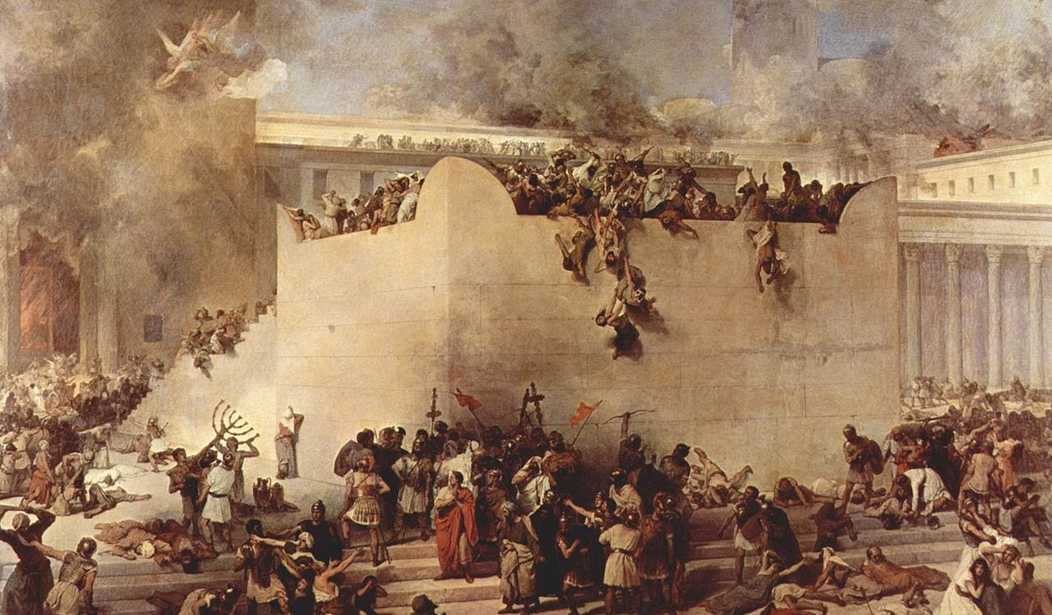In some respects, the most solemn period of the Jewish year is upon us. The fast, which is called simply by its date in the Hebrew calendar, Tish’a bë’va or the 9th of Av, comes as the culmination of a series of fasts, beginning with ‘Asara bëTeveth (the 10th of Teventh) and continuing with Shiv‘a ‘Asar bëThammuz (the 17th of Tammuz), in the winter and early summer, respectively.
The fundamental reason for the three fasts is the progress which was made by the forces of the Babylonians and, in their wake, the Romans, in destroying Jerusalem and the holy Temple. On ‘Asara bëTeveth the siege around the city was closed; on Shiv‘a‘Asar bëThammuz, the city wall was breached; and three weeks later, on Tish‘a bë’Av, resistance effectively ceased and the Temple went up in flames.
But this does not begin to describe the significance of the 9th of Av as a calamitous date in Jewish and, indeed, general history; a partial list of the other historical events which occurred on this date includes (the following list is by the Jewish year in which the event happened, followed by the secular count):
2448/-1312: The spies sent out by Moses to reconnoiter the promised Land on the eve of the planned invasion delivered their morale-destroying report of Canaanite military and economic capabilities, with the consequent revolt by Israel and prolongation of Israel’s time in the desert to 40 years, to enable the generation of the Exodus to die off.
3892/132: The Romans crushed the Bar Kokhba revolt, which had raged for three years, with the capture and reduction of the last stronghold of Beitar; as a result over 100,000 people were killed in the fighting.
3893/133: The Roman governor ordered the site of the Holy Temple ploughed (a symbolic act which meant that it was never to be occupied again), and established the Roman city of Aelia Capitolina on the ruins of Jerusalem, in which Jews were not permitted to settle.
4855/1095: The First Crusade began, in which an estimated 10,000 Jews lost their lives in the first month, and many thousands more afterward in the subsequent fighting.
5050/1290: The Jewish communities of England were expelled, with much suffering, not to return until Menashe ben Israel conducted his negotiations with Oliver Cromwell in 1655.
5252/1492: Queen Isabella of Spain issued her edict that the Jewish population be expelled from Spain, and subsequently from Portugal as well, initiating the Inquisition which resulted in the suffering and deaths of many thousands of people.
5674/1914: Great Britain and the Russian Empire declared war on Germany, initiating the Great War. Not only were millions of people killed in this war, but it led directly to the Russian Revolution and Civil War (which ended in 1923), and its unresolved issues led to the rise of fascism and National Socialism, ultimately culminating in the Second World War, the most destructive in history.
5702/1942: The deportations from the Warsaw Ghetto to the death camp at Treblinka commenced; at least 700,000 people perished in that camp alone.
5749/1989: Iraq walked out of talks concerning her invasion of Kuwait, with the consequence that the First Gulf War began.
5754/1994: The Argentine Jewish community center in Buenos Aires was bombed, killing 85 people and wounding approximately 300 more.
It should not be any wonder, then, that Tish‘a bë’Av is a general time of mourning. How do we observe it?
Shiv‘a ‘Asar bëThammuz begins a period of general mourning known as the Three Weeks, during which it is customary to avoid celebrations of any kind. This avoidance intensifies with the first of Av (the “nine days”), in which we generally avoid eating meat (except on the Sabbath), refrain from activities such as swimming, and so on.
The fast of the 9th begins at sundown, and is observed by a solemn service in which the scroll of Eicha (the Biblical book of Lamentations) is read, together with a selection of very intense liturgical poetry mourning the destruction of Jerusalem and the Temple generally known as qinnoth. We do not greet people on this occasion, and generally refrain from wearing leather and engage in other customs associated with mourning.
The next morning, we do not don tëfillin, as we would on any ordinary week day; we hold the morning shacharith service, reading from the Torah and again reciting Eicha, after which the rest of the morning is spent sitting on the floor or on very low chairs, reciting more qinnoth, which include commemorations of the massacres of the communities of Mainz, Wurms, and Speyer which initiated the First Crusade, and also include qinnoth related to the Holocaust of the 20th century. I personally recite qinnoth written by the Belzer rebbe, who narrowly escaped deportation to Auschwitz, and by Rabbi Shom‘on Schwab, a young German rabbi who escaped Nazi Germany in the 1930s.
In the afternoon, the spirit of mourning lessens somewhat; tëfillin are donned at the afternoon Mincha service, and there are often programs available to explain what it is that we are lacking without the Temple, and exhorting people to improve their behavior and general observance of Jewish law and custom, with the hope that this will be the last fast on Tish‘a bë’Av, the last tears shed, and our final redemption begun.









Join the conversation as a VIP Member